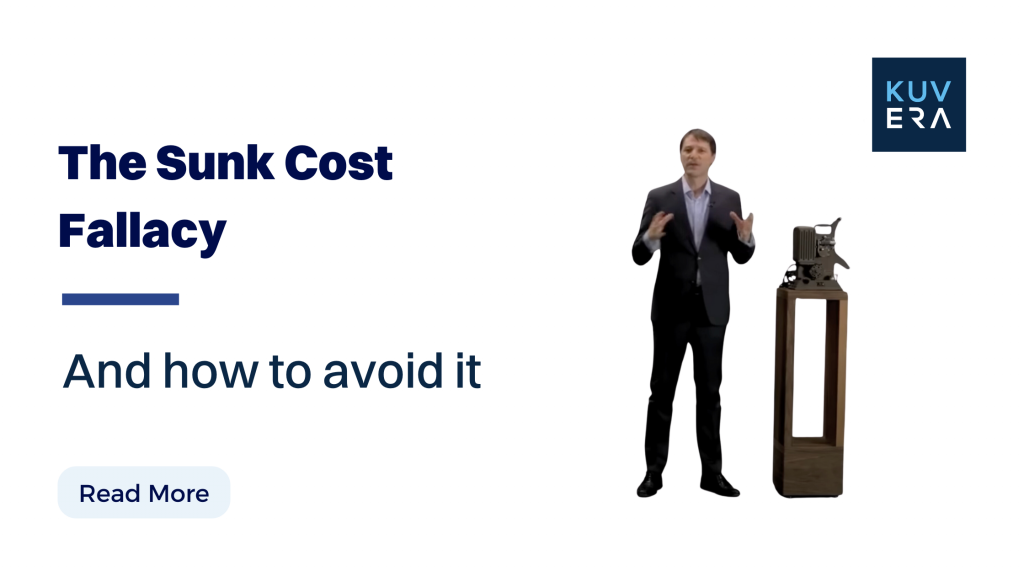This article will help you tackle an important aspect of decision-making, especially when it comes to handling our money – the sunk cost fallacy.
Meet Ralph Dobelli, who wrote The Art of Thinking Clearly. Ralph loves to simplify tricky ideas, and today he’s going to help us understand the trap of Sunk Cost.
A Story
Imagine Rajesh and his wife had already bought tickets to a movie for ₹2,000. These tickets were the kind you can’t get your money back on. On their way to see the film, they saw an absolutely stunning sunset. Rajesh suggested, “Why don’t we skip the movie and watch the sunset instead? It looks amazing!”
Despite the tempting sunset, his wife felt they should go to the movie because they had already spent the money on the tickets. This right here is what you call the sunk cost fallacy. It’s when you make a choice based on money or effort you’ve already spent, even if there’s a better option right in front of you.
How the Sunk Cost Fallacy Shows Up in Investing
This kind of thinking pops up a lot when people invest their money. Let’s say someone buys shares in a company, but then the price starts to drop. Even though it might be smarter to sell the shares, many hang on to them because they don’t want to admit they’ve lost money. They’re caught in the sunk cost fallacy, focusing on the past cost rather than what’s best for the future.
Here’s how you can sidestep this trap in your investment choices:
- Be Aware: Just knowing about the sunk cost fallacy can help you avoid it.
- Look Ahead: Think about what’s next, not what you’ve already spent.
- Let Go of the Past: Don’t let the time or money you’ve already spent make decisions for you.
New to investing? Know how much wealth can your monthly SIPs create! Click here.
Tips to Avoid Falling into the Sunk Cost Fallacy
If you want to keep clear of this trap, here are some friendly tips:
- Think About Now: Always check if sticking to your current plan is really the best use of your time or money.
- Make Rules for Yourself: Decide how you’ll make choices about your investments by looking at what’s happening now, not what happened before.
- Get a Second Opinion: Sometimes talking to a financial advisor can help you see things from a new angle, which might make it easier to make smart choices.
FAQs on the Sunk Cost Fallacy
Q1: What exactly is a sunk cost? It’s money or effort that you’ve already spent and can’t get back. It’s gone, so it shouldn’t affect your future choices.
Q2: Why is it tough to ignore sunk costs? It’s hard because we don’t like feeling like we’ve wasted something. This can make us stick with a bad choice instead of moving on.
Q3: How can knowing about the sunk cost fallacy help me with investing? Understanding this can make you a smarter investor. You’ll focus on what could happen in the future, not what you’ve already lost.
Q4: Does the sunk cost fallacy affect other parts of life? Yes, it can. Whether it’s sticking with a bad class because you don’t want to lose the credits, or staying in a job you don’t like because you’ve been there a long time, it’s the same mistake.
Conclusion
The sunk cost fallacy can really trip you up, not just with money, but in many parts of life. By understanding and overcoming this, you can make decisions that are better for your happiness and your wallet. Remember, when it comes to past costs—whether time or money—think about what’s best for your future. Thanks for joining us today, and remember to be careful with your investments. If you want to keep making smart money choices, check out more of our articles and videos.
Interested in how we think about the markets?
Read more: Zen And The Art Of Investing
Watch this video by Ralph Dobelli on the Sunk Cost Fallacy.
Start investing through a platform that brings goal planning and investing to your fingertips. Visit kuvera.in to discover Direct Plans and Fixed Deposits and start investing today.

